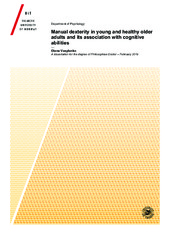Manual dexterity in young and healthy older adults and its association with cognitive abilities
Permanent link
https://hdl.handle.net/10037/15428Date
2019-05-21Type
Doctoral thesisDoktorgradsavhandling
Author
Vasylenko, OlenaAbstract
Background and aims - Much research has been conducted on age-related changes in cognitive function, but psychomotor abilities, such as manual dexterity, have been less studied. A better understanding is needed of which movement components account for the general slowing of performance and how central factors, such as cognitive decline, contribute to slowing. The aims of this thesis were to evaluate a) differences in manual dexterity of young and healthy older adults and b) the role of cognitive abilities in dexterity performance. Additionally, the contributions of gender and neuromuscular hand function were assessed.
Methods - A novel methodological approach combining the Purdue Pegboard Test and motion capture was employed. Movement times and kinematic parameters were obtained for four actions: reaching, grasping, transport, and inserting of pins. Cognitive abilities were assessed by a neuropsychological battery.
Results - Slowing of performance was found in both unimanual and bimanual tasks, but the amount of slowing differed by type of action. Whereas movement times of grasping and inserting were longer in older adults across all tasks and for both hands, reaching and transport were slower only when performed with the left hand. Kinematic differences were specific to movement type: for reaching and transport, the largest differences were in linear velocity; for grasping and inserting, in path length and angular velocity. Older males showed more slowing compared to females. Executive function was a significant predictor of dexterity in the older group, but not in the younger. Executive function was related to movement times during reaching and grasping, as well as to path lengths during grasping and inserting pins.
Discussion - These findings advance the current understanding of age-related dexterity decline and identify executive function as an important contributing factor. Results are relevant for dexterity assessment in research and clinical contexts. Future studies should investigate neural mechanisms of dexterity decline and its association with cognitive function.
Has part(s)
Paper I: Rodríguez-Aranda, C., Mittner, M. & Vasylenko, O. (2016). Association between executive functions, working memory, and manual dexterity in young and healthy older adults: An exploratory study. Perceptual and Motor Skills, 122(1), 165-192. Also available at https://doi.org/10.1177/0031512516628370.
Paper II: Vasylenko, O., Gorecka, M.M. & Rodríguez-Aranda, C. (2018). Manual dexterity in young and healthy older adults. 1. Age- and gender-related differences in unimanual and bimanual performance. Developmental Psychobiology, 60(4), 407-427. Accepted manuscript version available in Munin at https://hdl.handle.net/10037/14537.
Paper III: Vasylenko, O., Gorecka, M.M. & Rodríguez-Aranda, C. (2018). Manual dexterity in young and healthy older adults. 2. Association with cognitive abilities. Developmental Psychobiology, 60(4), 428-439. Accepted manuscript version available in Munin at https://hdl.handle.net/10037/15072.
Publisher
UiT The Arctic University of NorwayUiT Norges arktiske universitet
Metadata
Show full item recordCollections
The following license file are associated with this item:


 English
English norsk
norsk
